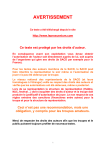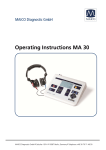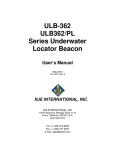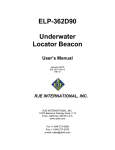Download Contents - Technisch bureau van Eeden
Transcript
Contents 1 2 3 4 5 6 7 8 9 10 11 12 13 14 Summary Machine directive Emission sound pressure level Noise exposure Sound power level deciBel Indoor measurements: environmental correction Standards for emission sound pressure measurement Basics of ISO 11201, 11202 and 11204 Uncertainty and declarations Installations and embedded machinery Buy quiet Examples of measurements Examples of declarations 2 2 2 3 4 5 6 6 7 x x x x x Disclaimer This document describes some aspects and content of harmonized standards. These descriptions solely gives the interpretation of the author thereof. The author can not be held responsible for any mistakes, damage of harm that might result from the application of the content of this document. Correct measurements of machine noise in relation the machine directive can only be executed when the person(s) performing this are educated and trained in sound measurement in general, and are fully informed about, and understand the content of all relevant standards. © All right reserved. No part of this document may be copied or distributed in any form without written consent or the publisher. Technisch bureau van Eeden . consultant noise and vibration PO Box 5027 . 5201GA ‘s-Hertogenbosch . the Netherlands Chamber of commerce 16082023 w w w. t b v e . n l van Eeden – Sound level measurements on machines, an introduction - page 1 of 20 1 Summary This documents aims to provide an overview of the way noise specifications for machines are established. It gives engineers, designers, sales and HSE executives general information on how noise measurements on machines should be executed. After reading this document one should be able to understand what conditions should be met to execute the measurements and what complications can arise, and one should be able to evaluate the integrity of noise data given by manufacturers and suppliers. 2 Machine directive The machine directive requires that machines built for the European market are designed and made in a way that health risks are reduces to a minimum. Too much noise is one of those risks. Best practice should be used to achieve that goal and the physical basics thereof are explained in ISO/TR 11688-2. Residual health risks of machines must be specified. Consequently a noise specification must always make part of the user manual. The emission sound pressure level must be specified. If this is below 70 dB, then it is sufficient only to mention that. If the emission sound pressure level is above 80 dB then the sound power of the machine must be determined and specified. 3 Emission sound pressure level Sound pressure level is what appears on the display of a sound level meter, if you use a good one. This sound pressure level varies with the distance to the source and also depends on the environment: if a noise source is placed in a small room the sound pressure level will be higher than if that same noise source is placed in a large room. So you may use good sound level meter and have a reliable display readout, the measurement is dependent on much more than only the acoustical properties of the source. A user or buyer of a machine must be able to compare the noise specifications that different manufacturers supply with their machinery. This requires that the specifications are established in a comparable way, what we call: under reproducible conditions. Emission sound pressure level : “sound pressure level, at a work station or another specified position near a noise source, when the source is in operation under specified operating and mounting conditions on a reflecting plane surface, excluding the effects of background noise as well as the effects of reflections other than those from the plane or planes permitted for the purpose of the test”. (ISO 11200) The emission sound pressure level requires the determination of the sound pressure level given: - a well defined position for operator or bystander - a specified operating condition, or a combination of conditions - an environment that is acoustically equivalent to an outdoor situation on a reflecting surface If all manufacturers of a family of machines do these measurements with the same operating condition(s) then the results can safely be used for comparison. van Eeden – Sound level measurements on machines, an introduction - page 2 of 20 4 Noise exposure Exposure to noise is the amount of noise that reaches the ear when performing a tasks. The emission sound pressure level of a machine just gives an indication of a part of that exposure when working on that specific machine. The emission sound pressure level is primarily intended to be used for comparison: all manufactures should measure it in the same way. The operating conditions in practice can be different, or very different, from the condition that is chosen for emission measurement. That depends on the application, processed materials and of course depends on the environment. Emission data may be used to estimate or predict partial exposure if there is no other resource available. Determination of exposure is preferably based on measurements, taking into account all relevant activities, all circumstances specific for the job or task, and given the environment in which a job is performed. Emission measurement on a specified position at fixed distance and height Exposure measurement: sound level meter is tied to the employee Measurement of emission has the machine as it scope, measurement of exposure has the worker as its scope. Reproducibility has priority when measuring emission, while representativeness has priority when measuring exposure. van Eeden – Sound level measurements on machines, an introduction - page 3 of 20 5 Sound power level Sound pressure level, that what appears on the display of a sound level meter, depends on the distance to a source and on the environment that source is placed in. The sound power level of a machine only depends on the operating condition. The difference between sound power and sound pressure can be shown with analogy of a heater. The heater with a power of, for example 5 kW can heat a room up to a certain temperature. The temperature that can be reached not only depends on the power of the heater but also on the size on the room and the quality of the thermal insulation. The power of the heater is property of that device, the room temperature is a resultant. In a room with only one operating machine the sound pressure level is a result of the sound power of the machine and the size of the room and the amount of absorption in the room. The sound power of the machine a fixed property, give a specified operating condition, the sound pressure level is the resultant. Experiment This you can do at home, if it is silent enough, to experience the relation between sound pressure and sound power. Switch on an electric toothbrush. Keep the toothbrush at fixed distance of your ears – best done by keeping it at arm length distance. Listen carefully and experience the loudness of the device. Holding the toothbrush at arm length, enter a toilet and close it. The loudness (sound pressure) rises. The toothbrush emits the same sound energy = it has a constant sound power. But the results of its sound power, that is the sound pressure, depends on distance and environment. What do we need sound power level for? • • • Sound power level is indispensable when predicting noise, and estimating possible exposure, in workplaces in a planning stage. For the purpose of comparison sound power provides valuable extra information, additional to emission: the sound power is not dependent on a certain position relative to the source, were emission can be strongly depending on that. Sound power level is almost indispensable when a local environmental correction must be calculated. The local environmental correction is needed when measuring in an indoor situation and the best possible correction calculation is wanted. van Eeden – Sound level measurements on machines, an introduction - page 4 of 20 6 dB: deciBel Sound pressure level and sound power level are both expressed in deciBel. That sounds confusing, but deciBel is a relative number. dB is also used for amplification (for example electronic circuits and antennas) and attenuation (for example cables). Any number can be expressed in dB: If 1 $ is taken as reference value, then the US national debt amounts 132,5 dB (March 2015: US debt is $ 18,156 1012 ). This shows that, amongst others, dB is very convenient to communicate about large (or very small) numbers. It also shows that only a number and decibel gives no information at all. A good and full description is always required. A value expressed in decibel is 10 times the logarithm of the value divided by a reference (with the same unit: 10∗log value reference The value divided by the reference can also be a amplification or attenuation, for example when dB is applied in electronics. Sound pressure level in dB: With p: sound pressure to expressed in dB. and p0: reference value of 20 µPa (2. 10-5 N/m2) Sound power level in dB: With P: sound power to be expressed in dB and P0: reference value of 1 pW (1. 10-12 Watt) The sound pressure p in Pascal is a small variation of the static pressure, it needs to be squared otherwise the average of that variation would be zero. Because sound power P is proportional to the square of the pressure variation ( p2) we obtain also a proportionality between Lp and LW. A smart choice of the reference values makes that this proportionality is simple one, as we will see in chapter XX. The ear is not linear: it is very sensitive to low level sounds, and the sensitivity decreases when the sound level increases. The human ears has an almost logarithmic response, that gives our hearing a huge dynamic range. A loudness scale in dB fits much better with our perception than a scale in Pa. van Eeden – Sound level measurements on machines, an introduction - page 5 of 20










